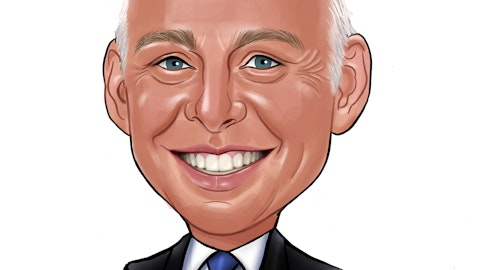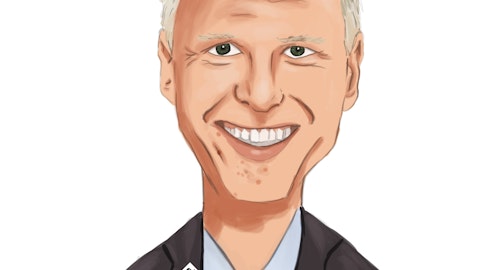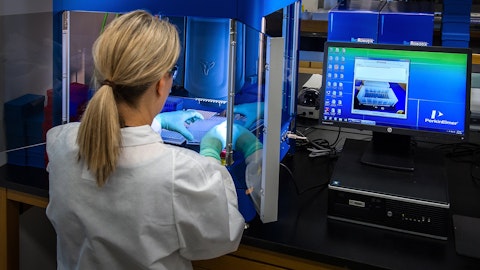Anthony Petrone: Oh, apologies. Line was muted. Good afternoon, Sunny and Sam. Maybe just staying on the theme here, the outlook. And to really splice it a little bit finer geographically. It sounds like it is broad-based? In other words, that you’re seeing similar sort of trends, whether it be in Europe and the U.S. specifically and maybe a little bit better as it relates to trends in China, although they’re currently going through COVID in the current quarter. So maybe just to fine tune it a little geographically, are the headwinds that you’re hearing from customers more acute in the U.S.? Are they more acute in Europe? How are they faring in China? And then I have a follow-up.
Sunny Sanyal: Sure. Anthony, it feels fairly broad-based, I would say. The variability right now we see is more in by modality. So modalities like dental, we did — we saw strength in dental, the fluoroscopy and oncology in these other mid-tier model. The non-CT modalities, they’re flat to down. And these are pretty heavy modalities that high price points and require a lot of work. And by the way, for those, our customers are in all regions of the world. And then CT felt, CT was soft, and not as much by geography. I don’t know if that helps to — answer your questions more by modality. And China is — their strength this is probably just a cyclical thing or just a consumption issue and COVID all that tied into some level of softness we’re not expecting anything dramatically different there.
Anthony Petrone : And then maybe more near-term in the first half, some of the chip companies and AMD and Intel called out just some lingering headwinds in 1Q, but that toward the back half of the year, the outlook for chips improves a bit. I mean, should we expect some of the pressure as you relate to your full-year guidance to be more front end loaded instead of back end loaded?
Sunny Sanyal: Yes, just one quick comment. We tend to be about 90, 120 days ahead of everyone else ahead of OEMs, right? Because of where we sit in the supply chain process. So if the OEMs end up clearing up their whip backlog that they’re currently stuck on, then things will start to open up for us in the second half. But again, that’s a bit unknown, because you can only see six months or so.
Sam Maheshwari: Yes. And then, Anthony, I can add if your question was also referring to cost side or the Intel, AMD pricing perspective and then how it goes to us on the cost side. We are also — we — when we are procuring chips, not just FPGAs, all kinds of chips, we go out many years. So — and many years, I mean, 12 to 24 months and in some cases even beyond 24 months. So of course, as the chip situation improves then what we would be procuring in second half, that would be favorable. But right now, what we have in inventory already is at high cost and that is what I think I mentioned in an answer to Young question before is that, that high-cost chips are in inventory now and they are rolling through. And based on our projections, most of that would have rolled through by — towards by the end of this calendar year. So that’s our situation. But whatever Intel, AMD, et cetera, are saying that would definitely help us in the future periods.
Anthony Petrone: Thank you very much. I’ll get back in queue. Thank you.
Sam Maheshwari: Thanks, Anthony.
Operator: Our next question is from Jim Sidoti with Sidoti & Company. Please proceed with your question.
Jim Sidoti: Hi, good afternoon. Thanks for taking the questions. First one on inventory, the increase in inventory, I guess two questions, why now? And now that you have inventories at this level, are you confident that you won’t have any stock out issues for the remainder of the year? Do you have all the key components you need for fiscal 2023?
Sunny Sanyal: Yes, Jim. Hi, Jim. Yes. So there are a couple of reasons for growth in inventory and inventory has increased for at least for a few quarters now. So as we began Q1, we were planning for a higher growth rate and so we were positioning our inventory accordingly. Going forward, we will adjust it somewhat to adjust the new forecast or new projections that we are planning. But I do want to remind you, because Q1 is a seasonally low revenue quarter for us, and that’s more on demand supply side and right now demand and supply are largely in balance. So the Q1 results were mostly a reflection of the demand levels. But from an inventory management perspective, we have to go on an even keel. So if you look at many — if you look at our prior Q1s and inventory performance there.
Generally, inventory in the last four, five years has grown by about $20 million. So in Q1, inventory grows by $20 million on where it ended in Q4. It’s because generally we grow in Q2, Q3 and Q4 is generally the high quarter for us. So growth of $17 million is not unusual for us from an inventory growth perspective. But I do accept that inventory was a bit high already. And so — and because as I said, we were driving towards a little bit higher revenue and so we’re now going to adjust it. And it should come down partially, because of our adjustment actions, but then also as revenue growth and the midpoint of our guidance is higher than Q1 actual revenue. So all of those things should help to bring down inventory going forward. So that’s the situation on inventory.
I hope, I answered your question, Jim.
Jim Sidoti: Okay. Yes, yes. And then we — following up on that, so I would assume and you’ll see positive cash flow from operations for the remainder of the year. As you start to work down that inventory?
Sunny Sanyal: Jim, generally, we do not guide cash flow from operations or cash balances. But provided, we are successful in bringing inventory down. That should provide — that should be a good factor to bake in for the cash performance of the company for the remaining quarters. In general, you’re thinking right, but I could not say that — I could not guide you to that, but in general, inventory should provide a positive response to cash as opposed to be a downward pressure on cash.
Jim Sidoti: Okay. And then is there any update on the joint venture with Micro-X and the expansion into Southeast Asia and India?
Sunny Sanyal: Yes. So Jim, on the Micro-X question, that is we — the Micro-X announcements that we had done. We have five milestones for through R&D to pay them for the technology transfer. It is in a way than acquisition financed through the P&L. In a way, you could look at it that way. So we are expecting one milestone was completed and we are expecting two more milestones to be completed in Q2. That is why our operating expense guidance in Q2 is a bit higher. And then after that two more milestones would be left; I do not have a specific view at this time when the remaining two milestones would be completed. So that’s that on — on that collaboration. And then your second question about Southeast Asia, that really South Asia and I believe you’re referring to our initiatives in India. Is that right?
Jim Sidoti: Right.
Sunny Sanyal: Yes. So in India, we’re making progress. We’ve made incremental progress at this time; we’ve made certain payments to the government for acquiring the land. We are just in the final phases of completing that purchase. Hopefully, we have made the payments and now we are trying to work towards getting the position and those type of agreements done. And so progress is full speed on that initiative. And look forward to having good things come out of that initiative in 12 to 18 months, more like 18 months, I would say.
Jim Sidoti: Okay. And then the last one for me, can you just repeat comments you made regarding interest expense and share count for the second quarter?
Sunny Sanyal: Yes. In terms of share count, given our EPS guidance range used for — due to ASU 2026 or yes, because of that, our share count for EPS calculation purposes, toggles between 41 million shares or 49 million shares. So for the Q2 guidance range for EPS, we are using 41 million shares. And then what’s the second question, Jim?
Jim Sidoti: The interest expense.




